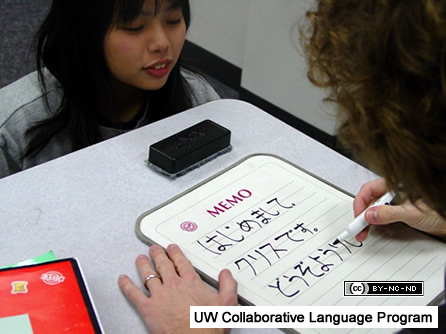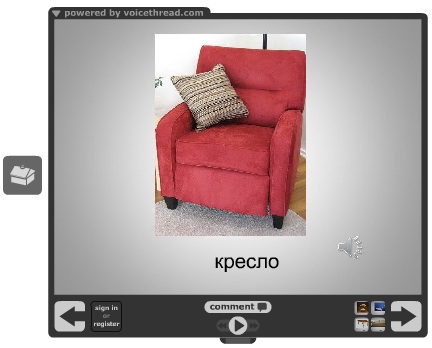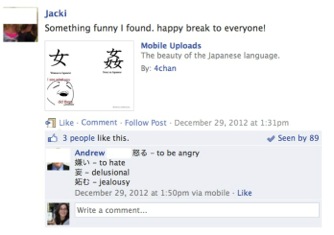Essential Elements of a Successful Language Consortium
 By Lauren Rosen, Director, Collaborative Language Program, University of Wisconsin.
By Lauren Rosen, Director, Collaborative Language Program, University of Wisconsin.
DOI: https://www.doi.org/10.69732/YLEA5398
“Over the past two decades, countries in the world have become more and more interdependent, and new technologies have erased many existing borders. As boundaries between countries are dissolved, foreign language instruction has become more necessary than ever for linking with the rest of the world and for producing an enlightened citizenship able to function in today’s ever-shrinking world.” (Morris 2002)

Morris’ quote is already more than a decade old and the need for competent speakers of languages is growing faster all the time. The rise of electronic news media that are reaching larger audiences in the last couple of decades has increased the awareness of the need for proficient speakers of LCTLs (Less Commonly Taught Languages). Subsequently, some of the languages that were once considered LCTLs, such as Arabic, Chinese, Japanese and Russian are now more commonly referred to as critical languages, critical to security and our economy. We have seen an increase in these languages being offered in smaller institutions. There are a number of consortia looking at ways to share these courses and others, in order to reach more students. These consortia seek to resolve issues such as a need to diversify language offerings, a lack of available qualified instructors, and funding for low enrolled courses. Couple the aforementioned logistical issues with today’s pedagogical focus on three modes of communication and the need to apply those modes in a globalized 21st Century environment, and you see a clear shift in the approaches to teaching and learning languages. We can no longer teach as we once learned. It has become increasingly important to develop advanced speakers of critical languages and LCTLs, and to develop new approaches to reaching more students in the process.
A BIT OF HISTORY
The UW System Collaborative Language Program (CLP) began diversifying language departments on smaller university campuses in 1998 with a videoconferencing course model for offering Japanese and Russian. Since that time, and with the advent of much improved and less expensive technology, it has evolved to a true blended approach. The CLP currently offers Arabic, Chinese, Hmong, Japanese and Russian. While it began with 86 students and four campuses, it now serves approximately 350 students per semester on ten campuses, averaging 28 first through fourth semester language courses per year. Some of these collaborations continue through six semesters of language, but at that point they have become independent from the support of the CLP. Campuses develop these independent agreements based on the model established by the CLP but without the oversight and funding that CLP offers in the first two years. The idea is that the CLP establishes beginning programs and once they are strong and stable the campuses involved have a vested interest in continuing to support these courses on their own. Interest in these critical languages through the affordances of the CLP has led to the addition of minor and major degree programs, tenure track positions on campuses that didn’t previously offer the language for which they now hold a permanent position, and the adoption of similar models by a number of other consortia around the country. Some of these consortia include the Course Share Initiative, described by Dr. Van Deusen-Scholl in a previous issue of FLTMag (2014), the Pennsylvania State System of Higher Ed (PASSHE), and the Committee on Institutional Cooperation (CIC) between Big Ten institutions.
A WORKING MODEL
So what is this model and how does it work? One must keep in mind that it is evolving with the available technology and the skills that incoming students and faculty have. The support of very dedicated administrators, faculty, and technical staff, who are open to change and the transformation of learning environments, have been the keys to a flexible evolving model. With a blended learning model, the premise is to have face-to-face time coupled with an online learning component.

The exact percentage of time for each and the way in which that time is spent varies. According to the SLOAN Consortium (2007), 30%-79% of instruction is delivered online in a blended model. In the CLP model, the face-to face component in first through fourth semester classes involves meeting four days per week over an interactive two-way videoconferencing (ITV) network. All students attend in specially equipped university classrooms so that they have a cohort of students with them for pair and small group activity. Students and instructors are able to communicate easily using voice and video technology. Using computers, smart tablets, document cameras, room and student cameras, materials are easily shared across the Internet with minimal lag and allowing for collaborative class work. The number of campuses connected for a single course in the CLP model is limited to no more than three, a maximum of 25 students total, and a minimum of four per site for first semester courses. In the first semester, several of our instructors allow up to 32 students knowing there will be some attrition. Their goal is to have a reasonable number of students for the 2nd year courses. While the instructor is present on the origination site campus, the receive site campus has a native speaker facilitator to help support students with pronunciation, organize pairs and groups, and to be a campus presence for students. These facilitators are usually international students with no background in teaching. It is preferred that they are not teachers so that they don’t override the directions of the instructor who remains the primary instructional contact for students. Facilitators also help start language tables and provide additional connections between the receive site students and the local influences of the culture and language being taught. Their perspective adds additional depth and currency to the content of the course as the instructor integrates the facilitator’s personal experiences into class sessions.

This facilitator model works well for face-to-face sessions with larger class sizes. However, it is less feasible and less necessary with smaller classes. The need for a facilitator may decrease with some LCTLs as well as with upper level language courses that attract only a couple of students at a receive site. These students are dedicated to learning the language. They are not typically in the class just to fill a requirement. That level of interest and the fact that there are fewer students means that the instructor, even from a distance, is often able to direct the distant classroom sufficiently well and manage class interactions. As a blended model there are a number of ways that students are also working on course content to develop their communication skills outside of class. Some of the technologies that are used include wikis for instructor and student work, Voicethread for instructional lesson modules and student performance, CLEAR Rich Internet Applications for student performance and oral assessment, ANVILL for oral practice, Google Drive for presentations and collaborative course documents, Skype for office hours, and many others. The richness of this blended model combines what we all know as strong communicative pedagogy and the integration of 21st Century technologies to afford communication and collaboration between all students and with the instructor, regardless of location.
FLEXIBILITY & COMMUNICATION
Many of you may be falsely thinking that this is easy to do in a single university system where there are no scheduling issues. It would be wonderful if that were the case. In fact, each of the University of Wisconsin System campuses is autonomous when it comes to scheduling. Class hours vary from 50, 55, or 60 minutes in length and passing time isn’t standardized either. Semester start and end dates and vacations do not coincide. Working around these differences requires a great deal of flexibility on the part of all instructors and campuses involved. Some of the strategies instructors have employed include having students work on collaborative digital projects while a connected campus is on spring break, recording class sessions to be streamed off a campus server, flipping lessons so the facilitator can serve as a guide when the instructor is not present, and using a variety of online technologies for students to connect and share their work. It is important that all instructors and students are able to take their designated breaks; therefore instructors come up with creative solutions without losing instruction and practice time. Scheduling courses is a multistage process that takes the best interest of students into consideration to ensure the highest possible enrollments. Instructor requests, campus timeslots, and available facilities are all part of the process. Often, courses begin or end during passing time on one campus to better accommodate another campus’ schedule. Students can’t afford to give up two class hours for a single course. All participating campuses are encouraged to check and double check timetables to make sure courses are scheduled correctly. Strong communication between stakeholders is essential. Growing language programs on receive sites can be challenging as there is less support for these languages and often fewer connections to a student’s course of study. In addition, different campuses have different requirements for language study. This can impact the continuation of a language beyond the first year. A few approaches taken that help are hiring instructors who are pedagogically very strong and are willing to go the extra mile to engage learners, building bridges to related area studies courses, and making connections to study abroad programs. Pedagogical skill transfers well to an ITV environment and instructors often report that the experience improves their planning, organization, and connection to students. Confident experienced instructors are often more willing to take risks and develop innovative approaches. The CLP chose a communicative approach to language learning so as to closely model classroom practices that have been proven to work. Instructors adapt their activities and assessments to reach and measure performance of all students equally, regardless of location. If oral interviews for receive site students are scheduled over Skype, local students are also to be assessed over Skype. The technology can be learned but connecting with students, having them practice the language in the same way as they are assessed later, and finding ways to make multiple classrooms feel like a single room takes an experienced, creative instructor. One of the keys to success is communication among all stakeholders. Beginning with the individual classroom, instructors have used closed Facebook groups to connect students outside of class. In analyzing the posts, there is clear evidence of interpretive, interpersonal, and presentational interactions in this online community. In addition to being used for announcements and questions, students in intermediate levels are assisting students in beginning levels with their learning. Students also share videos and other content they come across that is related to the target culture and language. The community that is built between students often continues past the life of the course as can be seen in this example of interpretive communication shared during semester break.

Looking at posts from the 2012-2013 school year across four courses, where participation in the Facebook group was voluntary in all but one course, the number of student posts was greater in all courses than instructor or facilitator posts. Students indicated that they felt comfortable communicating in this medium. Instructors also commented that students seemed more connected to each other as they got to know each other better through the types of content shared in the group. This content was often brought in to class for more in depth analysis and discussion. These groups provide a formative assessment of student engagement and serve as part of the online learning time while providing the instructor with student found content to connect to classroom practice. Summative assessments are performed using more targeted approaches and technologies such as Voicethread, Skype and CLEAR Conversations. Communication between language educators provides an important support network for both newer and more experienced faculty. A Facebook group was developed for CLP instructors to share resources and ask questions of other instructors working in similar teaching environments. Facebook was chosen because that is where instructors and students already are spending their time. For those who are less comfortable with Facebook, an alternative that would allow for similar sharing is Yammer. In order to grow programs in LCTLs, the courses need to be widely marketed, not just through the traditional campus methods for all courses. Communication with area studies faculty to bridge the content of their courses to that of the languages being offered is a great advertising venue. Posting to the social media avenues and listservs of student groups serves as a targeted approach. Additionally, advertising study abroad programs that allow the CLP students from any participating campus to apply with equal entry status as those who are on the originating campus provides extended opportunities for students to immerse themselves in the target culture. Furthermore, the CLP has a network of administrators and faculty that serve to advise the consortium. This infrastructure has been essential to the CLPs ability to grow both inside and outside of Wisconsin. Administrators are able to compromise on-campus policies, procedures, and financial models in the best interest of the consortium. Faculty come together on pedagogical approaches and building departmental support for both originating and receiving courses, dispelling myths of how adding these languages will negatively impact existing enrollments.
LANGUAGE CONSORTIA LEAD THE WAY
With a strong administrative structure in place and today’s technology, we are able to focus on growing critical language and LCTL programs with a sound pedagogical approach. Language pedagogy has always been at the forefront of innovation. We have been teaching in a communicative environment for decades whereas other disciplines are still experimenting with stepping away from a lecture format. Much of what we have learned by adapting to our blended model for distance learning also works well in traditionally taught language courses. We have seen how these approaches not only worked to grow language programs where they didn’t before exist, but they also can apply to other disciplines. In today’s economy and with current technological advancements, we anticipate seeing a growing number of these collaborations. Note: The UW System Collaborative Language Program (CLP) welcomes additional institutions to our consortia. For more information contact: lrosen@wisc.edu
REFERENCES
Allen, I. Elaine, Jeff Seaman, and Richard Garrett, Blending In The Extent and Promise of Blended Education in the United States. (Needham: Sloan-C™, 2007).
Garrison, D. R., and Norman D. Vaughan, Blended learning in higher education: framework, principles, and guidelines. (San Francisco: Jossey-Bass, 2008).
Morris, Bernadette. “Why study a foreign language?.” Learn NC. http://www.learnnc.org/lp/pages/759 (accessed May 9, 2014).
Van Deusen-Scholl, Nelleke. “The Shared Course Initiative: A Model for Instructional Collaboration Across Institutions.” The FLTmag. https://fltmag.com/the-shared-course-initiative/ (accessed April 12, 2014).

